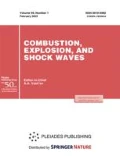Abstract
The ignition of methane–air mixtures with additives of ClF5, ClF3, OF2, and H2O2 (additive content in the mixtures \(\le\)1%) is studied by numerical simulation. The ignition temperature of the mixtures is determined as a function of the initial pressure and additive content. It is shown that the introduction of the additives into the mixture leads to a significant decrease in the ignition temperature due to the acceleration of the formation of reactive species and intensification of the chain mechanism of the process. Of the additives considered, chlorine pentafluoride is the most effective additive, and hydrogen peroxide is the least effective one.











Similar content being viewed by others
REFERENCES
A. M. Starik, B. I. Lukhovitskii, and N. S. Titova, “Initiation of Combustion of a CH4–O2 Mixture in a Supersonic Flow with Excitation of O2 Molecules by an Electric Discharge," Fiz. Goreniya i Vzryva 44, (3), 3–16 (2008) [Combust., Expl., Shock Waves. 44 (3), 249–262 (2008); https://doi.org/10.1007/s10573-008-0032-y].
A. M. Starik, B. I. Lukhovitskii, and N. S. Titova, “Mechanism of the Initiation of Combustion in CH4 (C2H2/Air/O3Mixtures by Laser Excitation of the O3 Molecules," Kinet. Katal. 48 (3), 368–387 (2007) [Kinet. Catal.48 (3), 348–366 (2007); https://doi.org/10.1134/S0023158407030032].
O. S. Van’kova, M. A. Gol’dfel’d, and N. N. Fedorova, “Controlling the Ignition and Combustion Stabilization Processes in a Supersonic Combustion Chamber," Vestn. Novosib. Gos. Univ., Ser. Fiz.11 (2), 46–53 (2016).
V. I. Golovitchev, M. L. Piliaf, and C. Brunei, “Autoignition of Methane Mixtures: The Effect of Hydrogen Peroxide," J. Propul. Power 12 (4), 699–707 (1996).
Chemmotology of Rocket and Jet Fuels, Ed. by A. A. Bratkov (Khimiy, Moscow, 1987) [in Russian].
M. Frenklach, H. Wang, C.-L. Yu, M. Goldenberg, C. T. Bowman, R. K. Hanson, D. F. Davidson, E. J. Chang, G. P. Smith, et al., http://combustion. berkeley.edu/gri_mech/new21/version12/text12.html.
C. T. Bowman, R. K. Hanson, D. F. Davidson, W. C. Gardiner (Jr.), V. Lissianski, G. P. Smith, D. M. Golden, M. Frenklach, and M. Goldenberg, http://combustion.berkeley.edu/gri_mech/new21/version21/ text21.html.
G. P. Smith, D. M. Golden, M. Frenklach, N. W. Moriarty, B. Eiteneer, M. Goldenberg, C. T. Bowman, R. K. Hanson, S. Song, W. C. Gardiner (Jr.), V. Lissianski, and Zh. Qin, http://combustion. berkeley.edu/gri_mech/version30/text30.html.
E. L. Petersen, D. F. Davidson, and R. K. Hanson, “Kinetics Modeling of Shock-Induced Ignition in Low-Dilution CH4/O2 Mixtures at High Pressures and Intermediate Temperatures," Combust. Flame 117(1/2), 272–290 (1999).
W. K. Metcalfe, S. M. Burke, S. S. Ahmed, and H. J. Curran, “A Hierarchical and Comparative Kinetic Modeling Study of C1–C2 Hydrocarbon and Oxygenated Fuels," Int. J. Chem. Kinet. 45, 638–675 (2013).
http://c3.nuigalway.ie.
E. L. Petersen and R. K. Hanson, “Reduced Kinetics Mechanisms for Ram Accelerator Combustion," J. Propul. Power 15(4), 591–600 (1999).
V. P. Zhukov and A. F. Kong, “A Compact Reaction Mechanism of Methane Oxidation at High Pressures," Prog. React. Kinet. Mech.43 (1), 62–78 (2018).
R. J. Kee, F. M. Rupley, and J. A. Miller, “Chemkin-II: A Fortran Chemical Kinetics Package for the Analysis of Gas-Phase Chemical Kinetics," Report No. SAND89-8009 (Sandia National Laboratories, Livermore, 1989).
W. Tsang and R. F. Hampson, “Chemical Kinetics Data Base for Combustion Chemistry. Part I. Methane and Related Compounds," J. Phys. Chem. Ref. Data 15 (3), 1087–1279 (1986).
R. J. Gilbert, K. Luther, and J. Troe, “Theory of Thermal Unimolecular Reactions in the Fall-Off Range. II. Weak Collision Rate Constants," Ber. Bunsenges. Phys. Chem. 87, 169–177 (1983).
NIST Chemical Kinetics Database. Standard Reference Database 17, Version 7.0, Release 1.6.8, Data Version 2015.09; https://kinetics.nist.gov/kinetics/index.jsp.
H. R. Sanchez, “Revisiting the Thermochemistry of Chlorine Fluorides," J. Comput. Chem. 38 (22), 1930–1940 (2017).
NIST Chemistry WebBook, SRD 69; https:// webbook.nist.gov/chemistry/.
E. L. Petersen, J. M. Hall, S. D. Smith, J. de Vries, A. R. Amadio, and M. W. Crofton, “Ignition of Lean Methane-Based Fuel Blends at Gas Turbine Pressures," J. Eng. Gas Turbines Power 129(4), 937–944 (2007).
U. Burke, K. P. Somers, P. O’Toole, et al., “An Ignition Delay and Kinetic Modeling Study of Methane, Dimethyl Ether, and Their Mixtures at High Pressures," Combust. Flame 162 (2), 315–330 (2015).
Author information
Authors and Affiliations
Corresponding author
Additional information
Translated from Fizika Goreniya i Vzryva, 2021, Vol. 57, No. 2, pp. 12–23.https://doi.org/10.15372/FGV20210202.
Rights and permissions
About this article
Cite this article
Agroskin, V.Y., Bravyi, B.G., Vasil’ev, G.K. et al. Effect of Molecular Additives on the Ignition of Methane–Air Mixtures. Combust Explos Shock Waves 57, 138–149 (2021). https://doi.org/10.1134/S0010508221020027
Received:
Published:
Issue Date:
DOI: https://doi.org/10.1134/S0010508221020027


